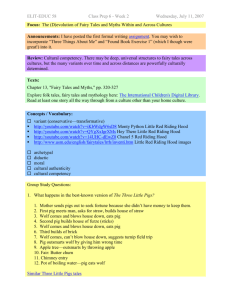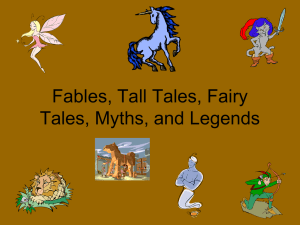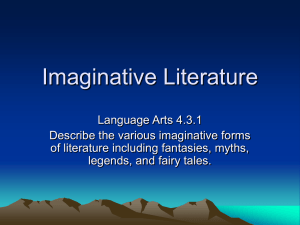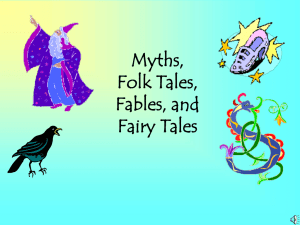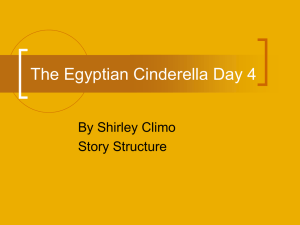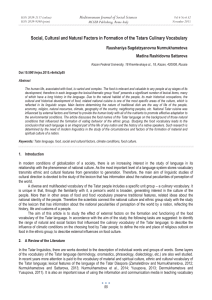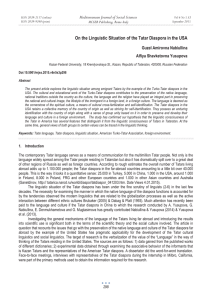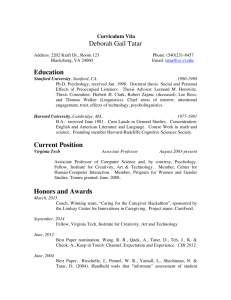Once Upon a Time
advertisement
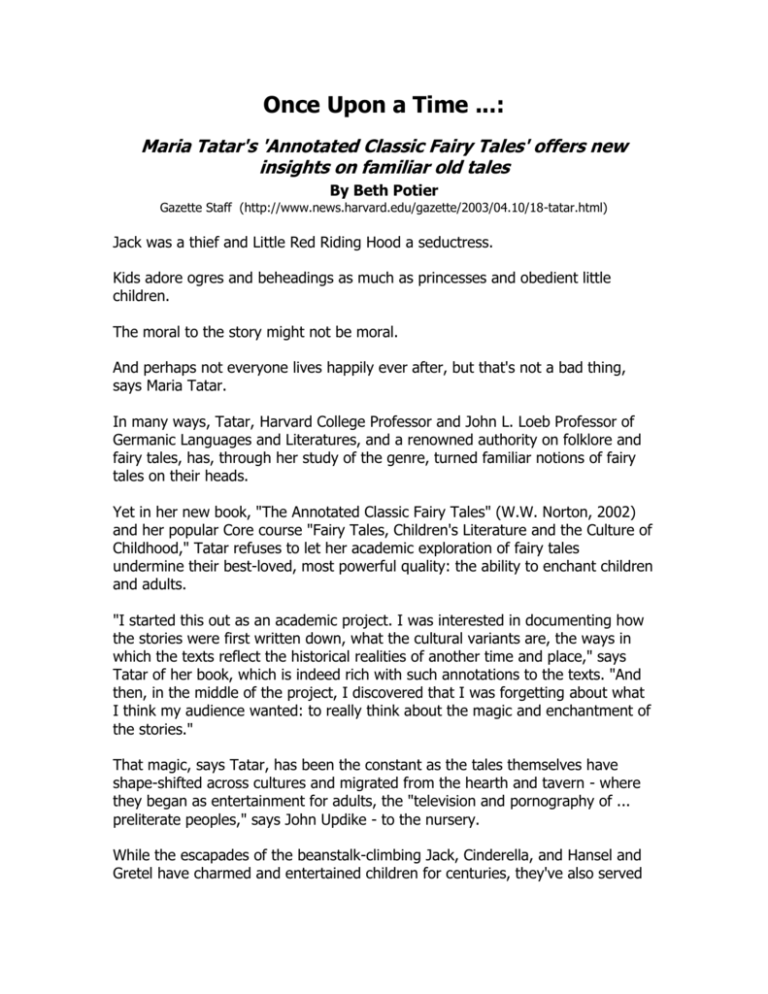
Once Upon a Time ...: Maria Tatar's 'Annotated Classic Fairy Tales' offers new insights on familiar old tales By Beth Potier Gazette Staff (http://www.news.harvard.edu/gazette/2003/04.10/18-tatar.html) Jack was a thief and Little Red Riding Hood a seductress. Kids adore ogres and beheadings as much as princesses and obedient little children. The moral to the story might not be moral. And perhaps not everyone lives happily ever after, but that's not a bad thing, says Maria Tatar. In many ways, Tatar, Harvard College Professor and John L. Loeb Professor of Germanic Languages and Literatures, and a renowned authority on folklore and fairy tales, has, through her study of the genre, turned familiar notions of fairy tales on their heads. Yet in her new book, "The Annotated Classic Fairy Tales" (W.W. Norton, 2002) and her popular Core course "Fairy Tales, Children's Literature and the Culture of Childhood," Tatar refuses to let her academic exploration of fairy tales undermine their best-loved, most powerful quality: the ability to enchant children and adults. "I started this out as an academic project. I was interested in documenting how the stories were first written down, what the cultural variants are, the ways in which the texts reflect the historical realities of another time and place," says Tatar of her book, which is indeed rich with such annotations to the texts. "And then, in the middle of the project, I discovered that I was forgetting about what I think my audience wanted: to really think about the magic and enchantment of the stories." That magic, says Tatar, has been the constant as the tales themselves have shape-shifted across cultures and migrated from the hearth and tavern - where they began as entertainment for adults, the "television and pornography of ... preliterate peoples," says John Updike - to the nursery. While the escapades of the beanstalk-climbing Jack, Cinderella, and Hansel and Gretel have charmed and entertained children for centuries, they've also served as a window into the world of grown-ups, providing a safe perch from which to explore childhood anxieties. "Fairy tales connect with all kinds of adult secrets," says Tatar. "They tell children about death, which is something that adults talk about in hushed tones. They tell them about romance and marriage and in some cases, they'll tell them about sex and violence." Witches and monsters and wolves, oh my! Sex and violence? In those innocent children's stories of sweetness and good? Indeed, says Tatar, fairy tales are often brutally violent, gushing over with bloodthirsty monsters, girleating wolves, wicked stepmothers, and wifekilling barons. What's more, kids love 'em that way. Kay Nielsen, 'Hansel and Gretel,' 1925. (Typ 905.25.4365F, Department of Printing and Graphic Arts, Houghton Library, Harvard College Library) "The real magic of the fairy tale lies in its ability to extract pleasure from pain," Tatar writes in the introduction to "The Annotated Classic Fairy Tales." It's this complex duality that fascinates her and, she says, that imbues fairy tales with powers therapeutic as well as entertaining. In "The Juniper Tree," for instance - a popular tale in Europe and one of Tatar's favorites - a story of breathtaking beauty and poetry is shot through with bloodcurdling violence. A stepmother beheads her stepson, leaves the grisly discovery to her daughter, serves the boy in a stew to his father, then meets her just desserts under the fatal crush of a millstone. In a movie or video game, such lurid stuff might not pass parental censure, but in a fairy tale, it delights. "Children think it's hilarious when the millstone comes down and kills the stepmother," says Tatar. Such violence in fairy tales helps children come to terms with fears for which they don't yet have language. "Something complicated is happening when those children are laughing, something that has to do with the fact that they are weak and vulnerable and that they have a lot of anxieties which they don't have the words to talk about," she says. The interactive delivery of fairy tales - a trusted adult usually reads them aloud to a child, fostering improvisation and discussion that's absent in passive entertainment like videos - further enhances their therapeutic qualities. Parents or adults provide their own cultural translations and reassuring explanations that can help allay childhood fears. The moral of the story ... What fairy tales don't do, says Tatar, is provide tidy moral lessons for young learners. "Our culture has this profound belief in literature as conveying lessons to children," she says. She is a vocal critic of this notion. Tatar notes that morals were often added or appended to fairy tales when they were rewritten for children. In many cases, they have nothing to do with the story. Little Red Riding Hood would have encountered the wolf en route to Grandma's whether or not she dallied to pick flowers. "Does keeping to the path really help you avoid wolves in the forest? Unlikely, I think," says Tatar. She notes other tales in which the stated morals run counter to the stories' messages. "Bluebeard," the story of a murderous lord and the young wife who outwits him, concludes with the maxim "Curiosity, with its many charms, can stir up serious regrets." The young wife meets Bluebeard's wrath when she opens a forbidden room and discovers the corpses of his previous wives. But rather than stirring up regrets, the wife's inquisitiveness saves her from a similar fate. "Clearly her curiosity was very important there, because she discovered that her husband was a serial killer," says Tatar. In addition, moral ambiguity abounds in some of children's favorite fairy tale characters - the trickster children who overcome their much larger foes through wit and cunning. Although he's considered the hero, Jack is a thief, climbing the beanstalk to rob the giant of his gold. And in a French oral version of Little Red Riding Hood, no hunter saves the young girl and her granny; instead, Little Red Riding Hood hoodwinks the wolf by performing a striptease for him. Challenged by students Tatar gives much of the credit for her book to the students who have taken her Core course, which explores fairy tales as a point of departure for considering broader cultural issues of childhood. "There's nothing like a group of Harvard students to get you to rise to the challenge of finding answers to questions both large and small about these stories," she says. The course syllabus includes grown-up readings by Locke, Rousseau, Nabokov, and Angela Carter as well as Maurice Sendak's "Where the Wild Things Are," Roald Dahl's "Charlie and the Chocolate Factory" and, of course, lots of fairy tales. Its complexity and rigor catch some students off guard. "It is less daunting than Milton or Shakespeare ... but one of the surprises they get is that the stories are not as simple as they think," says Tatar. The study of fairy tales and childhood demands skills of literary criticism and psychology, as well as anthropology, history, and folklore. Tatar revels in the collaborative nature of teaching, her own discoveries enriched by her students' questions and insights. Yet she parts company with many of her students on one of today's most prominent icons of the culture of childhood: Although charmed by the grip they have on readers' imaginations, she can't slog through the "Harry Potter" books. "I have enough trouble with the real world, and suddenly there's this other world, where everything has a new name," she says of J.K. Rowling's wildly popular fantasy series. "I have trouble mastering the rules of soccer. I don't want to have to learn about Quidditch."



